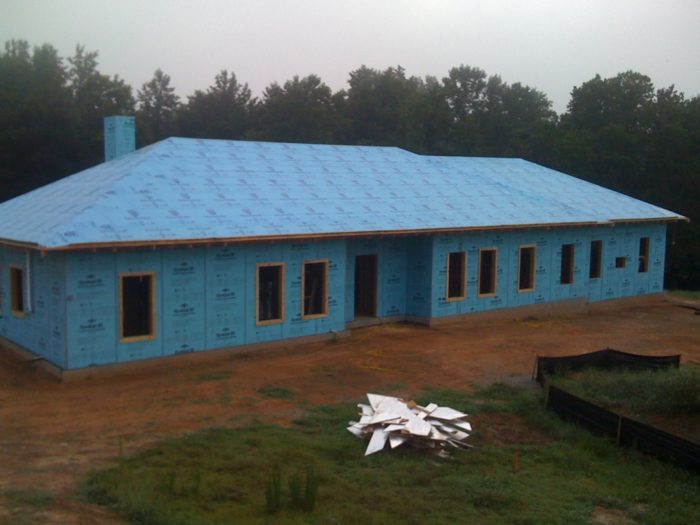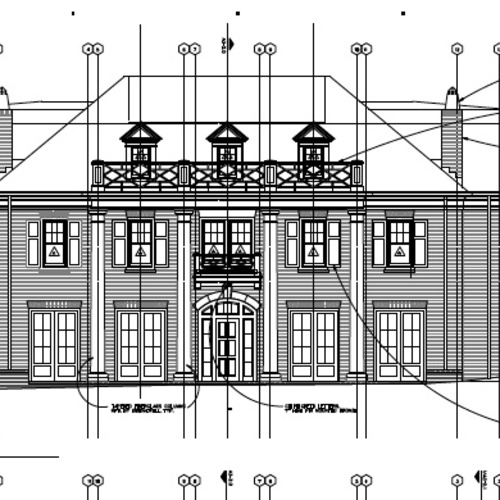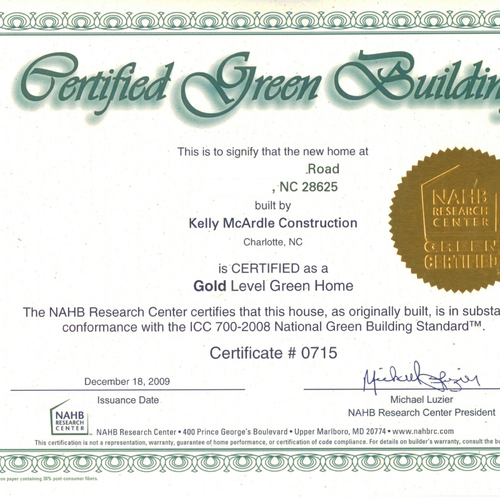
Image Credit: Danny Kelly
We had already walked and jogged on our journey to green, but we began to worry that we would miss out on our chance to run. We had a pretty good reputation as one of the few builders in town familiar with green building, but the real estate market was headed down, so we weren’t building any more spec homes. We introduced all of our new customers to a range of green building programs, but none of them were very interested.
Back to the classroom
In an effort to expand our knowledge and create a new revenue source for our company, I got certified as a Building Analyst by the Building Performance Institute. This was probably the best class I had taken to date. That was when the whole “house as a system” idea really clicked in my head.
After that class, everything I read made much more sense. When I needed to make decisions, I was able to ask much better questions of our subs and suppliers. I would recommend this class to any new home builder — even if you have no intention of building green or getting into energy audits or weatherization. (I would also recommend doing some remodeling and home repair – nothing teaches how to build better than seeing houses that were not done properly).
This was also about the time that GreenBuildingAdvisor came online, so I spent hours every night reading all the new articles.
Clients with a vision
While working as an exhibitor at one of the local green building events, we met a fascinating couple who wanted to build a LEED Platinum home. Finally – our chance to run. What made it better: this couple had a mission to build their green house for an average cost. We were very excited to work with this couple and really liked the fact they had an alternate purpose to building a green home.
So we got a project team together and started working on the specifications. This project got under way right after the National Green Building Standard had come out. We recommended doing that certification as well as LEED for Homes — in order to compare the two rating programs — and they were up for it.
While working through the checklists for the two certifications, we learned about the DOE Builder’s Challenge. We all liked the fact that the house must score below 70 on the HERS Index — other green building programs don’t really insist on a target HERS number — so we thought this would be a good thing to shoot for as well. We were really running now!
Reconsidering advanced framing
After conducting a few energy audits, I had a new appreciation for advanced framing. As we looked at what we thought were well-built homes, we were shocked at how cold the studs were during the winter months in some of the houses we visited. We immediately knew that we needed to improve our thermal envelope and reduce thermal bridging.
We spent a lot of time looking at cost-versus-value on the thermal envelope. We finally decided on 2×6 wall construction, 24 inches on center, with blown-in insulation, rigid foam sheathing, and radiant barrier roof sheathing.
I was still a little reluctant on the 24-in. spacing so I called the Sheetrock manufacturer to ask if ½-in. Sheetrock would be okay. The manufacturer said that in a vertical application, the ½-in. thickness would be plenty. On a horizontal application, however, we should use Type X or go to 5/8 in. Since we were on a tight budget, we kept with the ½ in. If I were doing this on a more expensive house, I would probably consider upgrading to 5/8 in. everywhere.
Will the walls be able to dry?
One of the first things we did was to contact the manufacturers to get spec sheets on all the new products we were planning to use, to be sure we understood how to install them properly. In addition, we needed this documentation for the certifications as well.
While looking at Dow Structural Insulated Sheathing (SIS), I saw that the perm rating was under 0.3. This worried me – it appeared that everyone in the green world recommended exterior foam as a thermal break, but this meant installing a vapor retarder on the outside of your wall. We had always learned from Fine Homebuilding and BuildingScience.com that in our climate you don’t want to have a vapor barrier in your wall; you want to allow the wall to dry in both directions. This is opposite of everything we had learned over the years.
Well – I went to my favorite website, GBA, and asked them what they think. The site proved to be a great resource, and I had some great discussions and received good advice. I also asked several other questions on the site as well — we had moved to a high-performance felt as well, but that too was putting a vapor barrier on our roof which concerned us. But after speaking with the experts at GBA, we felt much more comfortable about where we were headed.
Careful planning yields rewards
We learned our lesson — don’t move forward without having a firm plan — so we had many meetings with our verifier and all of our subs. We went through every detail and every point of the home before we started. Some of the other features we included in the home: passive solar design, a solar water heater, a rainwater harvesting system, an ERV, and a very high-performance HVAC system. Of course we used Energy Star appliances and lighting fixtures, Water Sense plumbing fixtures, low VOC paints, locally produced and non-formaldehyde cabinets and countertops, etc.
We had a great verifier and the construction process went very smoothly. It was nice to have the homeowners so involved in the process – we felt like it was more of a team approach rather than us working for them. All inspections went well and when we ran our blower-door test, we got the lowest reading our verifier had ever done. We ended up with a HERS Index of 52, and the house was built for $126 per square foot. We felt like we had accomplished all of our goals.
The house was one of only three LEED Platinum homes in the state of North Carolina, and the first Gold-certified house in the National Green Building Standard program. You can learn more about this house here.
Danny Kelly is a co-owner of Kelly McArdle Construction in Charlotte, North Carolina.
Weekly Newsletter
Get building science and energy efficiency advice, plus special offers, in your inbox.















9 Comments
congrats
That's a great story. We've figured out the high performance part but are working on the cost part. It's great that you achieved both right off the bat.
Costs are the issue but it's nice
Great house, but most people can't afford $275-300,000 for a new house. You said it "cost" $126 sf and according to the homes' website it is 2200 sf but does that include the land? "Green" is great but most of America can't afford it. That doesn't mean don't do it, every drop helps because at some point the bucket will overflow. I agree with Dan need to work on the cost. We need a $99k-$199k green house. Chicken and the egg, all new adapters of technology pay more than later adapters. I have enjoyed following your journey.
Some more detail on the costs
I guess when discussing “costs” it is all relative. As a custom builder, the majority of our homes we build range from $125 - $200 per square foot – so we felt like we had accomplished something by building a green high performance home on the lower end of that range. To keep the price in line – it is all about trade offs. We obviously spent more money in areas like windows, HVAC, insulation, etc. but where we managed to save money was the real trick. Interior trim was minimal – Sheetrock returns on windows and no crown moulding, kitchen countertops were laminate. Our finished floor was concrete so we did not have any floor finishes. We were initially going to stain it but after we cleaned it the homeowners liked the natural look so much we left it alone. Advanced framing pretty much offset the upgrade from 2x4 to 2x6 walls. We recycled all of our trash so saved approx. $1500 by not having any dumpsters onsite. We used pedestal sinks in al bathrooms to avoid cabinets and tops. This was possible only because our homeowners were willing to sacrifice on some of the luxuries and finishes - you really can't have both unless you are willing to pay for it. The banks and appraisers are not really helping right now either.
These same principles could apply to a production home but what really drives this is the market. Most homeowners would prefer to put their money towards expensive cabinets, countertops, stone and appliances. Things do seem to be turning around though - we are beginning to see some people ask about efficiency. For years we would always offer HVAC upgrades to our customers and we only had one person in 10 years take the upgrade from a code 10 SEER unit to a 13 SEER unit. The past few years more and more people are taking us up on and asking about "green" options.
Thanks for the thoughts - hopefully through sites like this we will spread the good word and more consumers will jump on board.
Blower Door results and Air Control
Danny,
What was the CFM 50?
Can you describe your Air Control layer(s)
What kind of wall Blown in? did you use netting?
Where was the thermal control layer ... at the ceiling or the roof deck?
Where was the mechanical equipment and ducts?
Response to John
I do not recall the CFM50 off the top of my head - will have to track down my notes. I think it was under 500.
Air controls layers. Floor was the conceret slab. Ceiling was Sheetrock. Exterior walls both the Sheetrock and the DOW SIS.
Blown in was Climate Pro Blown in Blanket System with netting:
http://www.jm.com/insulation/building_insulation/products/bid0019_climatepro_bibs.pdf
The density of this was 2.3 lbs/cubic foot so did not qualify as our air barrier but did get us an R-23 in a 2x6 wall plus our R5.5 from the 1" of DOW SIS.
Initially we were going to do an unvented roof but our owner did not want to use spray foam and we were having a hard time coming up with a way to get our required air barrier below the insulation in a cost effective manner. We consulted with our rater and he told us we actually had a lower HERS with the thermal envelope being at the ceiling level due to the increased surface area having it at the roof. We decided our best value and lowest HERS was R-38 blown in at the ceiling and radiant barrier roof sheathing. We were a little disappointed that we were then putting our HVAC unit and all duct work in the vented attic. To address this issue we built a conditioned room for the unit to go in and extended our thermal envelope up into the attic for this one section. Figured the unit itself was more important than the duct work. We then used the radiant barrier sheating to make up for the duct work being in the vented portion of the attic. We framed this house in the summer and was really impressed with how well the radiant barrier sheathing worked. Our HVAC installers liked it so much they turned a one week rough into a three week job.
Air Tight Drywall
Good to see that you are getting a tight house without sprayfoam
Did you use Airtight Drywall strategy?
Mechanical "penthouse" may be a good strategy until we can get to more compact HVAC
Have you looked at Daikin ducted mini-split?
Pricey but very compact.
Airtight Drywall Approach
John - was not really aware of the ADA when we did this so we ended up about halfway there. Did not use gaskets everywhere but we did use caulk at the perimeter of each sheet and after it was installed went up in the attic and sealed all boots, lights, etc very well with caulk and foam.
Thanks for the new term - I like Mechanical Penthouse - yes not ideal but will probably perform pretty well. We did not get any points on either of our Green Building Certifications, even though we had the unit in a conditioned room the ductwork was not so we did not take those points - figured we did not meet the intent of what they were trying to accomplish. Did not help on our HERS either, but I'm sure in the real world it is better than if we had just left it in the attic.
Jave not heard of Daikin - will have to look into it. We used Carrier - seemed to have the best ability to dehumidify and compatible with ERV, etc.
Nice job, Danny
We've generally managed to avoid mechanicals in the attic by making use of unvented crawl space but when that's not possible the Mechanical Penthouse is a great addition to the toolkit.
Scott: I don't know where you are located but $126/sf is a real achievement in the custom market in most areas, and Danny laid out what needs to happen to get there with a high-performance home: establish priorities and cut the frills first. And a $99K - $199K high-performance house is perfectly possible at these rates. You just need to build a home that is right-sized to your needs and your budget. Most families can live very well indeed in a home that's 1600 sf or less, if it's properly designed.
Cost
My husband and I are owners of the Mean Lean Dream Green Home that Danny Kelly built for us. I wanted to take a minute to address cost. The $124 per square foot is the house alone. If you include the fact that we have a fully finished, heated, air conditioned two-car garage and workshop attached to the house, the cost of the house drops to $96 per square foot. We found no standard for the cost calculation and chose to error on the high side . . .but we consider our cost at $96 per square foot as the garage was finished to the same specs as the house.
Log in or create an account to post a comment.
Sign up Log in